Wingnut Wings 1/32 DH.9a "Ninak"
|
KIT #: |
32007 |
|
PRICE: |
$89.00 SRP (which includes shipping) |
|
DECALS: |
Five options |
|
REVIEWER: |
Tom Cleaver |
|
NOTES: |
New mold kit |
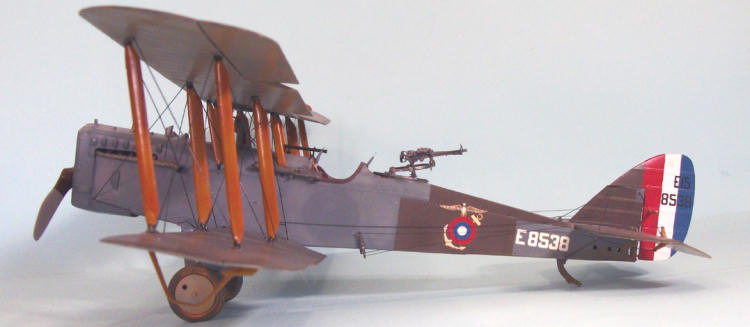
The
AMC
DH.9a (Aircraft Manufacturing Company de Havilland design 9a) bomber came about
due to the necessity to find a replacement for the underperforming DH.9, which
had been introduced as a replacement for the 275‑350hp Rolls Royce Eagle powered
DH.4, with the pilot and gunner repositioned closer together for improved
communications. The DH.9 was in
fact a great leap backwards due to the inferior performance and unreliability of
its 230hp Puma engine.
The initial design for the
improved DH.9a was created by
Westland
Aircraft, due to workload considerations at
AMC,
and differed primarily by being designed to use the 400hp
Liberty
V-12 developed and produced in the
United States.
With larger wings and re‑designed
nose, the prototype C6350 began
flight testing in February 1918. The 2nd prototype was the first to be fitted
with a
Liberty
engine, and C6122 took to the air on April 19, 1918.
The need for the airplane was such that an initial production order for
400 DH.9a was given to Whitehead Aircraft in January 1918, a month before the
first prototype flew. The DH.9a was manufactured by Whitehead,
AMC,
Mann Eggerton & Co. and The Vulcan Motor & Engineering Co., in addition to
numerous rebuilds and small post war production orders from de Havilland
Aircraft Co, Handley Page, HG. Hawker Engineering Ltd. and Short Bros among
others, as the D.H.9a along with the
Bristol
F2B became the backbone of the postwar RAF during the 1920s and early 1930s.
An American order for 4000 USD‑9A was placed with Curtiss but was
canceled due to the Armistice; only 13 USD‑9A were built, all prototypes. At
least 2,700 unlicensed copies were built in the newly formed
Soviet Union
as the Polikarpov R‑1.
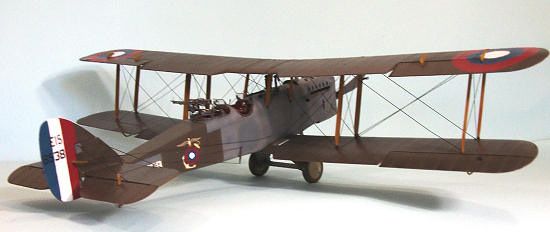 The DH.9a “Ninak” (Nin = 9, ack = A) became operational with 110 Squadron
of the Independent Air Force of the Royal Air Force (the strategic bombing force
headed by General Hugh Trenchard)at the end of August 1918. While 110 Squadron
was the only unit in
France
fully equipped with the DH.9a before the Armistice, D.H.9a aircraft also made up
part of the aircraft complements of 99 Squadron, 18 Squadron, and 55 Squadron of
the IAF. The
United States
Marine Corps replaced their thoroughly-unusable American D.H. 4s with 53 DH.9as
for the USMC Northern Bombing Group in September, 1918, and flew them until the
Armistice. After the war, the DH.9a
served with the RAF in Germany, Russia and the Middle East and saw service in
the Canadian Air Force, the Australian Air Corps as well as the Soviet Union and
China (which was supplied the R‑1 version).
The D.H.9a left RAF service in 1934, having been used on the periphery of
Empire in such locations as
Iraq
and
Afghanistan
for local “aerial policing” (i.e., bombing uppity natives who weren’t enamored
of their enforced membership in the
British Empire).
The DH.9a “Ninak” (Nin = 9, ack = A) became operational with 110 Squadron
of the Independent Air Force of the Royal Air Force (the strategic bombing force
headed by General Hugh Trenchard)at the end of August 1918. While 110 Squadron
was the only unit in
France
fully equipped with the DH.9a before the Armistice, D.H.9a aircraft also made up
part of the aircraft complements of 99 Squadron, 18 Squadron, and 55 Squadron of
the IAF. The
United States
Marine Corps replaced their thoroughly-unusable American D.H. 4s with 53 DH.9as
for the USMC Northern Bombing Group in September, 1918, and flew them until the
Armistice. After the war, the DH.9a
served with the RAF in Germany, Russia and the Middle East and saw service in
the Canadian Air Force, the Australian Air Corps as well as the Soviet Union and
China (which was supplied the R‑1 version).
The D.H.9a left RAF service in 1934, having been used on the periphery of
Empire in such locations as
Iraq
and
Afghanistan
for local “aerial policing” (i.e., bombing uppity natives who weren’t enamored
of their enforced membership in the
British Empire).
The USMC Northern Bombing
Force:
Marine Corps Aviation began on
May 21, 1912,
when USMC Lt Alfred A Cunningham received Naval Aviator's Certificate number 5.
Further expansion of Marine Aviation between 1912 to the entrance of the
United States
into World War I was slow; the entire force on
April 6, 1917,
was 5 officers and 30 enlisted men on duty at NAS
Pensacola,
Florida.
On
February 13, 1917,
Lt F. T. Evans climbed to 3,000 feet in a Curtiss N-9 single‑pontoon seaplane
and looped and spun the airplane, which had previously been considered
impossible. Promoted to Captain in
October 1917, Evans commanded the original tactical aviation unit, the First
Marine Aeronautic Company, which was sent to the
Azores
in December 1917 to fly anti‑ submarine patrols as the first completely-equipped
American aviation unit to leave the Continental
United States
for war service.
The remaining 26 officers soloed at
Mineola,
in December, 1917, in temperatures far below zero. On arrival at Gerstner Field
in Louisiana, the Marines found the Army had hundreds of new airplanes in
crates, a large number of cadets awaiting instruction, several thousand drafted
men who had never seen an airplane, and only a handful of pilots and experienced
mechanics. All hands in the Marine Squadron, including the cooks, assisted in
assembling the airplanes, and the Marine pilots became flying instructors.
Four more squadrons were formed at Miami, under the command of Marine
Aviator No.1, Maj. Alfred A. Cunningham, and arrived in France in July, 1918, to
become the Day Wing of the Northern Bombing Group, operating in the Dunkirk area
against German submarines and their bases at Ostend, Zeebrugge, and Bruges.
Arriving in July and August, the Marines flew with the British while
awaiting delivery of their own airplanes.
When 72 American-built D.H.4s finally arrived in early September 1918,
they were found to be unusable due to poor quality control during production and
had to be completely reassembled.
The Marines were able to obtain 53 ex-RAF D.H.9as which were flown on 57 raids
during the 61 days of the war remaining, despite the fall of 1918 being one of
the rainiest on record. The Marines
shot down 12 German fighters, for the loss of only one airplane. It was
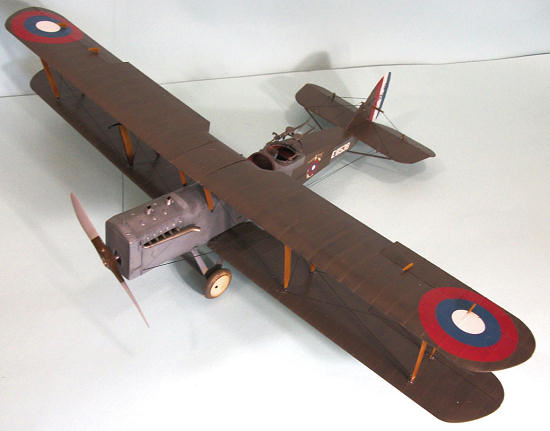 learned
after the Armistice that one raid had resulted in the death of 60 enemy officers
and 300 enlisted men.
learned
after the Armistice that one raid had resulted in the death of 60 enemy officers
and 300 enlisted men.
The Marines may only have been in combat a little more than two months,
but they wrote an epic tale in several bloody battles.
One of the more amazing feats was the aerial rescue of a French regiment
cut off by the enemy near Stadenburg. Marine Corps pilots successfully dropped
2,600 pounds of food to them in the face of heavy fire from artillery, machine
guns, and rifles over the course of two days. Three pilots were killed or died
of wounds received in action, two of them being shot down over the enemy's
lines. Captain Robert Lytle received the following Distinguished Service Medal
citation:
"For
extraordinary heroism as commanding officer of Squadron C, First Marine Aviation
Force, at the Front in bombing raids into enemy territory. On October 2, 1918,
when word was received that a body of French troops had been cut off from
supplies for two days by the enemy, and it was decided to feed them by aeroplane,
Captain Lytle flew over the besieged troops at an altitude of only one hundred
feet and dropped food where these troops could get it. This performance was
repeated four times, each time under heavy fire from rifles, machine guns and
artillery on the ground.
“On
October 14, 1918, while leading a raid of seven planes near Fittham, Belgium,
his plane and one other became separated from their formation on account of
motor trouble, and were attacked by twelve enemy scout planes. Captain Lytle
shot down one of the enemy planes, and before his motor quit entirely, landed
under fire in the Belgian front line trenches."
On October 14, 1918, the Marine squadrons of the Northern Bombing Group
flew the first of eight American missions against German targets. In all, the
eight raids saw 15,502 pounds of bombs dropped on enemy held territory.
On October 22, 1918, Marine aviators Harvey C. Norman and Caleb W. Taylor
were shot down and killed. Both received the Navy Cross posthumously with the
following citations:
“The
Navy Cross is presented to Harvey C. Norman, Second Lieutenant, U.S. Marine
Corps, for extraordinary heroism as a Pilot in the First Marine Aviation force,
attached to the Northern Bomb Group (USN), at the front in France. While on a
bombing raid into enemy territory, October 22, 1918, Lieutenant Norman became
separated from the other planes of his formation, owing to heavy fog and while
so cut off was attacked by seven enemy scout planes. In the engagement which
ensued he behaved with conspicuous gallantry and intrepidity, continuing the
fight against overwhelming odds until he himself was killed and his plane shot
down.”
“The
Navy Cross is presented to Caleb W. Taylor, Second Lieutenant, U.S. Marine
Corps, for extraordinary heroism as an Observer in the First Marine Aviation
Force, attached to the Northern Bomb Group (USN) at the Front in France. While
on a bombing raid into enemy territory on October 22, 1918, Lieutenant Taylor
became separated from the other planes of the formation on account of fog, and
was attacked by seven enemy scout planes. Despite the overwhelming odds he
fought with great gallantry and intrepidity until he was killed and his plane
shot down.”
Observer/gunner Sergeant Thomas L. McCullough was awarded
the Navy Cross for action on September 9, 1918:
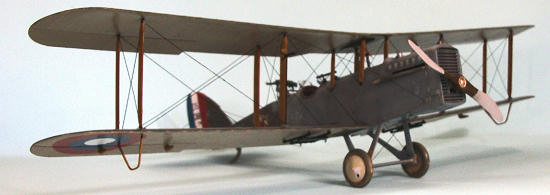 “The
Navy Cross is presented to Thomas L. McCullough, Sergeant, U.S. Marine Corps,
for extraordinary heroism as an Observer in the First Marine Aviation Force,
attached to the Northern Bomb Group (USN), at the Front in France. Sergeant
McCullough participated successfully in numerous air raids into enemy territory
and on September 9, 1918, while flying over Cortemarck, Belgium, was attacked by
eight enemy scouts. Sergeant McCullough shot down one of the enemy planes and
fought off the others until his gun jammed and he was forced out of action.
“The
Navy Cross is presented to Thomas L. McCullough, Sergeant, U.S. Marine Corps,
for extraordinary heroism as an Observer in the First Marine Aviation Force,
attached to the Northern Bomb Group (USN), at the Front in France. Sergeant
McCullough participated successfully in numerous air raids into enemy territory
and on September 9, 1918, while flying over Cortemarck, Belgium, was attacked by
eight enemy scouts. Sergeant McCullough shot down one of the enemy planes and
fought off the others until his gun jammed and he was forced out of action.
On September 28, 1918, First Lieutenant Everett R. Brewer and his
observer/gunner, Gunnery Sergeant Harry B. Wershiner both won the Navy Cross for
action while flying with 218 Squadron RAF:
“The Navy Cross is presented
to Everett R. Brewer, First Lieutenant, U.S. Marine Corps, for extraordinary
heroism on September 28, 1918, as a Pilot of the First Marine Aviation Force,
attached to the Northern Bomb Group (USN), while on an air raid in company with
Squadron 218, Royal Air Force. Lieutenant Brewer was attacked over Cortemarck,
Belgium by fifteen enemy scout planes. During the severe fight which followed,
his plane was shot down and although both himself and his observer were very
seriously wounded, he brought the plane safely back to the aerodrome. Lieutenant
Brewer was shot through the hip and his observer shot through the lungs.
Considering the distance from Cortemarck to his aerodrome this is a remarkable
instance.
“The
Navy Cross is presented to Harry B. Wershiner, Gunnery Sergeant, U.S. Marine
Corps, for extraordinary heroism as an Observer of the First Marine Aviation
Force, attached to the Northern Bomb Group (USN), while on an air raid in
company with Squadron 218, Royal Air Force, at the Front in France. On September
28, 1918, while on an air raid into enemy territory, his plane was attacked by
fifteen enemy scouts. Despite the overwhelming odds Gunnery Sergeant Wershiner
fought with great gallantry and intrepidity. He shot down two enemy scouts and
although he was himself shot through the lungs and his pilot shot through the
hips, he continued to fight until he was able to shake the enemy.
Second Lieutenant Chapin C. Barr won the Navy Cross on September 26,
1918:
“The
Navy Cross is presented to Chapin C. Barr, Second Lieutenant, U.S. Marine Corps,
for extraordinary heroism as a Pilot in the First Marine Aviation Force,
attached to the Northern Bomb Group (USN), at the front in France. On September
26, 1918, while on an air raid over enemy territory, Lieutenant Barr was
attacked by a superior number of enemy scouts. In the fight which ensued he
behaved with conspicuous gallantry and intrepidity, and despite having been
mortally wounded, he drove off the enemy and brought his plane safely back to
the aerodrome.”
Future Marine Corps aviation legend and Second World War battlefield
commander Captain Roy S. Geiger received his first wartime recognition as a
member of the Northern Bombing Force:
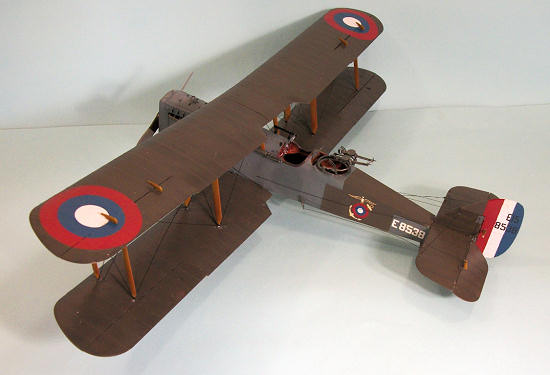 “The
Navy Cross is presented to Roy Stanley Geiger, Captain, U.S. Marine Corps, for
distinguished service in the line of his profession as Commanding Officer of
Airplane Squadron No. 2, 1st Marine Aviation Force, attached to the Northern
Bomb Group (USN), in which capacity he trained and led this Squadron on bombing
raids against the enemy. His conduct throughout was in keeping with the highest
traditions of the Navy of the United States.
“The
Navy Cross is presented to Roy Stanley Geiger, Captain, U.S. Marine Corps, for
distinguished service in the line of his profession as Commanding Officer of
Airplane Squadron No. 2, 1st Marine Aviation Force, attached to the Northern
Bomb Group (USN), in which capacity he trained and led this Squadron on bombing
raids against the enemy. His conduct throughout was in keeping with the highest
traditions of the Navy of the United States.
America’s highest award, the Medal of Honor, was awarded to Second
Lieutenant Ralph Talbot and Gunnery Sergeant Guy Robinson:
“For
exceptionally meritorious service and extraordinary heroism while attached to
Squadron C, 1st Marine Aviation Force, in France. 2d Lt. Talbot participated in
numerous air raids into enemy territory. On 8 October , 1918, while on such a
raid, he was attacked by 9 enemy scouts, and in the fight that followed shot
down an enemy plane. Also, on 14 October , 1918, while on a raid over Pittham,
Belgium, 2d Lt. Talbot and another plane became detached from the formation on
account of motor trouble and were attacked by 12 enemy scouts. During the severe
fight that followed, his plane shot down one of the enemy scouts. His observer
was shot through the elbow and his gun jammed. 2d Lt. Talbot maneuvered to gain
time for his observer to clear the jam with one hand, and then returned to the
fight. The observer fought until shot twice, once in the stomach and once in the
hip and then collapsed, 2d Lt. Talbot attacked the nearest enemy scout with his
front guns and shot him down. With his observer unconscious and his motor
failing, he dived to escape the balance of the enemy and crossed the German
trenches at an altitude of 50 feet, landing at the nearest hospital to leave his
observer, and then returning to his aerodrome.”
“The
President of the United States of America, in the name of Congress, takes
pleasure in presenting the Medal of Honor to Gunnery Sergeant Robert Guy
Robinson, United States Marine Corps, for extraordinary heroism as observer in
the 1st Marine Aviation Force at the front in France. In company with planes
from Squadron 218, Royal Air Force, conducting an air raid on 8 October 1918,
Gunnery Sergeant Robinson's plane was attacked by nine enemy scouts. In the
fight which followed, he shot down one of the enemy planes. In a later air raid
over Pittham, Belgium, on 14 October 1918, his plane and one other became
separated from their formation on account of motor trouble and were attacked by
twelve enemy scouts. Acting with conspicuous gallantry and intrepidity in the
fight which ensued, Gunnery Sergeant Robinson, after shooting down one of the
enemy planes, was struck by a bullet which carried away most of his elbow. At
the same time his gun jammed. While his pilot maneuvered for position, he
cleared the jam with one hand and returned to the fight. Although his left arm
was useless, he fought off the enemy scouts until he collapsed after receiving
two more bullet wounds, one in the stomach and one in the thigh.”
The Day Wing returned to the United States in December 1918 and was
disbanded, with most of its personnel returning to their civilian lives.
Today, Marine Attack Squadron 231 is considered their direct lineal
descendant.
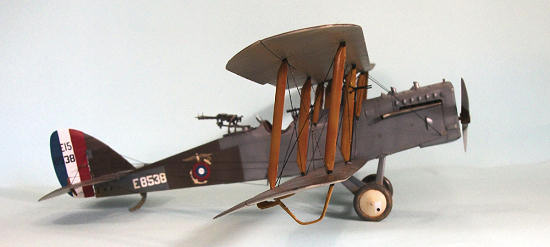 The Ninak is definitely one of the biggest of the Wingnut Wings
airplanes, being second only to the Gotha for overall size, and is the first kit
of the D.H.9a to appear in any scale.
In fact, the only other model of this airplane I have ever seen was John
Alcorn’s incredible 1/24 scratchbuilt Ninak that appeared at the 1998 IPMS-USA
convention. As with all Wingnut
Wings kits, it is superbly designed with attention to ease of assembly.
The kit provides different details such as different machine guns for
each of the five aircraft - four RAF and one USMC - that can be created from the
kit. The Cartograf decal sheet is
again among the best WW1 decal sheets, with accurate colors and a myriad of
stencil detail.
The Ninak is definitely one of the biggest of the Wingnut Wings
airplanes, being second only to the Gotha for overall size, and is the first kit
of the D.H.9a to appear in any scale.
In fact, the only other model of this airplane I have ever seen was John
Alcorn’s incredible 1/24 scratchbuilt Ninak that appeared at the 1998 IPMS-USA
convention. As with all Wingnut
Wings kits, it is superbly designed with attention to ease of assembly.
The kit provides different details such as different machine guns for
each of the five aircraft - four RAF and one USMC - that can be created from the
kit. The Cartograf decal sheet is
again among the best WW1 decal sheets, with accurate colors and a myriad of
stencil detail.
I have said it before with every review of a Wingnut Wings kit, but the
secret to success with these models is to follow the excellent instructions.
If you do so, the only reason you will not have a superb model at the end
will be “operator error” somewhere along the line.
The kit is complex but not complicated, and if you take your time any
modeler who has done at least one kit with advanced rigging will have no problem
creating a masterpiece.
I began as I always do by prepainting every detail part before assembly.
I did the wooden struts by painting them Tamiya “Desert Yellow”, then dry
brushing a very little bit of Tamiya “Red Brown” over them, followed by a solid
coat of Tamiya “Clear Yellow.”
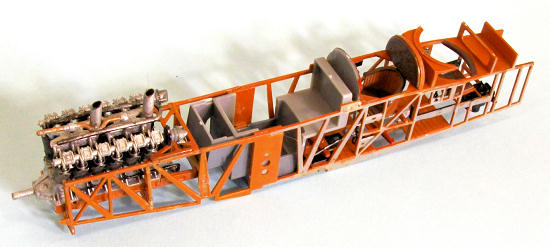 With that painting done, I proceeded to commit the radical act of
following the instructions in assembling the model.
With that painting done, I proceeded to commit the radical act of
following the instructions in assembling the model.
The inner fuselage detail is where assembly begins, with the cockpits and
then the engine. These are then
enclosed in the fuselage. Be
certain when you begin what airplane you want to do, because the instructions
point out the detail differences between each as you go along and you need to
know that before you start. As an
early D.H.9a, my Marine airplane had the fabric rear fuselage side panels, which
are cleverly done to show the “sagginess” of the fuselage fabric which was
nowhere near as tight as that of the wings.
I elected to enclose the very nice Liberty Engine in the cowling, but a
modeler who takes the time to add the wiring detail will be well rewarded if
they leave the cowling off and the engine visible.
I had decided I was going to try a trick of wing assembly and rigging
told me by another modeler, so after I assembled the wings I made very certain
that they could slip in and out of the fuselage and upper wing center section
easily, by scratching the openings a bit wider and taking the edges off of the
tabs on the wings. This involved
test-fitting as I went along.
Once the fuselage, wings and tail sub-assemblies were completed, it was
time to paint the outer airframe.
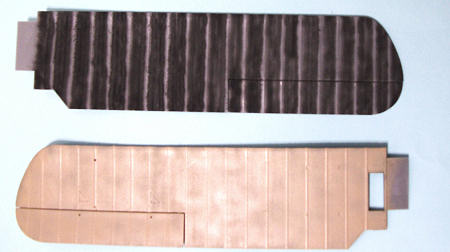 I pre-shaded the wings and tail surfaces by air brushing flat black in
the area between the ribs, leaving the ribs a lighter color.
I then applied Gunze-Sangyo “Sail Color”, thinned 50-50, for the lower
“clear doped linen” colors. I
applied Tamiya “Khaki Drab”, again thinned 50-50, for the upper surface color.
The grey areas were painted with the new Tamiya “Ocean Grey”, which is a
good match for British “Battleship Grey.”
I finished off with a coat of Xtracrylix “Gloss” clear varnish.
I pre-shaded the wings and tail surfaces by air brushing flat black in
the area between the ribs, leaving the ribs a lighter color.
I then applied Gunze-Sangyo “Sail Color”, thinned 50-50, for the lower
“clear doped linen” colors. I
applied Tamiya “Khaki Drab”, again thinned 50-50, for the upper surface color.
The grey areas were painted with the new Tamiya “Ocean Grey”, which is a
good match for British “Battleship Grey.”
I finished off with a coat of Xtracrylix “Gloss” clear varnish.
The decals went on without problem under a coat of Micro-Sol.
I did note a fit problem with the national insignia on the upper wing.
Be sure not to apply these with the wing and aileron separated; Apply the
larger piece to the wing, then apply the smaller piece over that and position it
so the color rings match up. When
they were set, I washed everything to get rid of decal solvent residue, then
gave everything a final coat of Xtracrylix “Satin” clear varnish.
I decided to do as much of the rigging before assembling the wings as
possible. This is a process that
works very well if you are using wire for your rigging.
If you are using thread, then you want to proceed with the usual assembly
and then run the
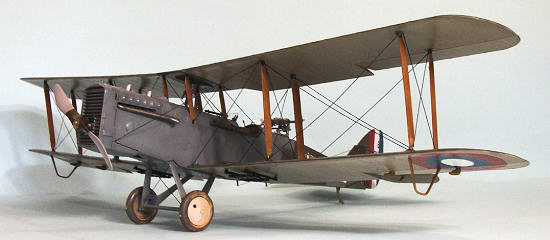 rigging
threads. I used .010 wire for this
rigging, and was very happy to discover that the D.H.9a did not have double
flying wires, as do most British WWI airplanes.
rigging
threads. I used .010 wire for this
rigging, and was very happy to discover that the D.H.9a did not have double
flying wires, as do most British WWI airplanes.
First I attached the upper wing center section in place with its struts.
Then I attached the interplane struts to each lower wing.
Be certain to test-fit this assembly by putting the top wing on (I
suggest you open the positioning holes for the struts a bit to insure ease of
fit) and slide that into the fuselage and wing to be sure everything is at the
correct angles.
I then took off the upper wings and did all the interplane rigging other
than the two inner bay flying wires.
When all was set up, I attached the top wings and finished the rigging of
those last wires. I then slid each
outer wing into position and glued them in.
I finished off by doing the rear control wires, using .006 wire.
I then attached the bomb racks and the Scarff ring and twin Lewis guns,
and the prop. I will attach the
bombs later, but doing all the decals for them was creating too much delay in
finishing this review.
Another winner from Wingnut Wings.
A brutal-looking British two-seater that is really impressive size-wise
when it sits on the shelf next to the other WNW models.
Since the Ninak was used extensively in the post-war period, an
enterprising modeler can create a number of different paint schemes and squadron
markings if they so desire. A
modeler with experience of building World War I models with rigging will have no
problems doing this model. Highly
recommended.
Tom Cleaver
October 2011
Thanks to Wingnut Wings for
the review sample. Order yours at:
www.wingnutwings.com
If you would like your product reviewed fairly and fairly quickly, please contact the editor or see other details in the
Note to
Contributors.
Back to the Main Page
Back to the Review
Index Page



 learned
after the Armistice that one raid had resulted in the death of 60 enemy officers
and 300 enlisted men.
learned
after the Armistice that one raid had resulted in the death of 60 enemy officers
and 300 enlisted men.

 The Ninak is definitely one of the biggest of the Wingnut Wings
airplanes, being second only to the Gotha for overall size, and is the first kit
of the D.H.9a to appear in any scale.
In fact, the only other model of this airplane I have ever seen was John
Alcorn’s incredible 1/24 scratchbuilt Ninak that appeared at the 1998 IPMS-USA
convention. As with all Wingnut
Wings kits, it is superbly designed with attention to ease of assembly.
The kit provides different details such as different machine guns for
each of the five aircraft - four RAF and one USMC - that can be created from the
kit. The Cartograf decal sheet is
again among the best WW1 decal sheets, with accurate colors and a myriad of
stencil detail.
The Ninak is definitely one of the biggest of the Wingnut Wings
airplanes, being second only to the Gotha for overall size, and is the first kit
of the D.H.9a to appear in any scale.
In fact, the only other model of this airplane I have ever seen was John
Alcorn’s incredible 1/24 scratchbuilt Ninak that appeared at the 1998 IPMS-USA
convention. As with all Wingnut
Wings kits, it is superbly designed with attention to ease of assembly.
The kit provides different details such as different machine guns for
each of the five aircraft - four RAF and one USMC - that can be created from the
kit. The Cartograf decal sheet is
again among the best WW1 decal sheets, with accurate colors and a myriad of
stencil detail. With that painting done, I proceeded to commit the radical act of
following the instructions in assembling the model.
With that painting done, I proceeded to commit the radical act of
following the instructions in assembling the model. I pre-shaded the wings and tail surfaces by air brushing flat black in
the area between the ribs, leaving the ribs a lighter color.
I then applied Gunze-Sangyo “Sail Color”, thinned 50-50, for the lower
“clear doped linen” colors. I
applied Tamiya “Khaki Drab”, again thinned 50-50, for the upper surface color.
The grey areas were painted with the new Tamiya “Ocean Grey”, which is a
good match for British “Battleship Grey.”
I finished off with a coat of Xtracrylix “Gloss” clear varnish.
I pre-shaded the wings and tail surfaces by air brushing flat black in
the area between the ribs, leaving the ribs a lighter color.
I then applied Gunze-Sangyo “Sail Color”, thinned 50-50, for the lower
“clear doped linen” colors. I
applied Tamiya “Khaki Drab”, again thinned 50-50, for the upper surface color.
The grey areas were painted with the new Tamiya “Ocean Grey”, which is a
good match for British “Battleship Grey.”
I finished off with a coat of Xtracrylix “Gloss” clear varnish. rigging
threads. I used .010 wire for this
rigging, and was very happy to discover that the D.H.9a did not have double
flying wires, as do most British WWI airplanes.
rigging
threads. I used .010 wire for this
rigging, and was very happy to discover that the D.H.9a did not have double
flying wires, as do most British WWI airplanes.